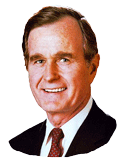Forty-First President of the United States
| Term: | January 20, 1989 – January 20, 1993 |
| Party: | Republican |
| Full name: | George Herbert Walker Bush |
| Born: | June 12, 1924 |
| Birthplace: | Milton, Massachusetts |
| Nicknames: | 41; Papa Bush; Poppy |
| Education: | Yale University |
| Vocation: | Oil Industry Businessman |
| Height: | 6 ft 2 in (188 cm ) |
| Hair Color: | Gray |
| Eye Color: | Blue |
| Religion: | Episcopalian |
| Spouse: | Barbara Pierce Bush |
| Children: | George W Bush (b. 1946); Pauline Robinson “Robin” Bush (b. 1949 deceased at age 4); John Ellis “Jeb” Bush (b. 1953); Neil Mallon Bush (b. 1955); Marvin Pierce Bush (b. 1956); Dorothy Bush (b. 1959) |
About George H. W. Bush
Straight out of high school, George Herbert Walker Bush enlisted in the US Navy following the Japanese attack on Pearl Harbor in 1941, postponing his college plans to do so. By signing up on his 18th birthday, he became the youngest aviator in the Navy at the time. Bush served numerous roles in the war, including as a combat pilot in the pacific theater, and saw much battle. During one mission, Bush’s plane was hit and heavily damaged by Japanese anti-aircraft fire, forcing him to flee over the open ocean and eject, to await rescue in a raft. His service continued until the end of the war when he was honorably discharged with numerous decorations.
 When his service was complete, Bush continued with his academic plans and attended Yale University, graduating in 1948 with a Bachelor of Arts degree in Economics. Having already married, he moved with his family to West Texas and entered the oil business, in which he thrived. By the time he was 40, Bush owned his own company and was a millionaire.
When his service was complete, Bush continued with his academic plans and attended Yale University, graduating in 1948 with a Bachelor of Arts degree in Economics. Having already married, he moved with his family to West Texas and entered the oil business, in which he thrived. By the time he was 40, Bush owned his own company and was a millionaire.
Initially far less successful in politics than in business, Bush’s public career struggled out of the gate. While he did enjoy a successful bid for a seat in the House of Representatives, Bush suffered several defeats in his attempts to be elected to the Senate, despite encouragement and a ringing endorsement in one such run from then-President Richard Nixon. Over time, however, Bush would rise to be Ambassador to the United Nations, Chairman of the Republican National Committee, and Director of Central Intelligence.
Bush persevered in seeking the presidency, as well. He failed to win his party’s nomination for the 1980 election, which instead went to Ronald Reagan (who would go on to win the general election as well). However, despite a contentious campaign against Reagan, Bush agreed to be his Vice President, serving in that capacity during both of Reagan’s terms. In 1988, in the twilight of the Reagan administration, Bush finally had his day; he was elected President, defeating Democratic hopeful Michael Dukakis.
In an interesting correlation with his son and future occupant of the White House, George W, Bush was at first an extremely popular President – and considerably less so as time went on. He oversaw military action in Panama against the dictator Manuel Noriega and ordered “Operation: Desert Storm”, in which the United States intervened to liberate the small nation of Kuwait following an invasion by Iraq. When Kuwait was free, people speculated at the time that the US should press into Iraq and remove Saddam Hussein as a dictator, but Bush declined to extend the mission. It would be his son, over a decade later, who would finally oust Hussein – and encounter many of the difficulties in occupying Iraq that his father feared in the ’90s.
Bush’s popularity flagged toward the end of his term, as the US economy began to sputter after the prosperity it had enjoyed under Reagan. At one point, Bush chose to renege on a categorical campaign promise he had made while running, in which he unambiguously declared the famous words, “Read my lips: no new taxes” if he were elected. When he, in fact, did raise taxes despite this assurance, it was a political disaster that followed him into the ’92 election. Bush was defeated by Democratic challenger Bill Clinton, denied a second term in office.
